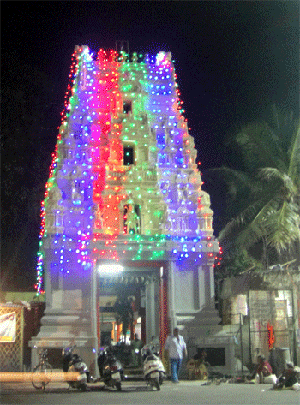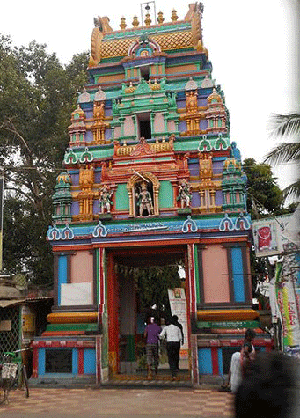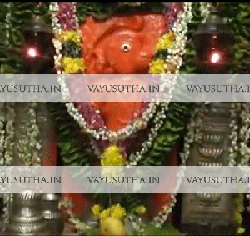
Guntur
 Guntur, a city in Andhra Pradesh is famous for its red chilies and tobacco, which is exported across the globe. It is an ancient and old city situated on the fertile plains of the Krishna River. The proximity of Guntur to the city Amaravati, which is the capital city of present Andhra Pradesh, makes it an all the more important city.
Guntur, a city in Andhra Pradesh is famous for its red chilies and tobacco, which is exported across the globe. It is an ancient and old city situated on the fertile plains of the Krishna River. The proximity of Guntur to the city Amaravati, which is the capital city of present Andhra Pradesh, makes it an all the more important city.
This ancient place Guntur is considered the second oldest evidence of the civilisation of humans in India, in the form of Palaeolithic (Old Stone Age) implements. Ancient history dates back to the time of the Sala kings who ruled during the 5th century BC. One of the earliest references to the present name of the city can be dated back to the period of Ammaraja–I (922-929 CE), the Vengi Eastern Chalukyan King. It is also mentioned in another two inscriptions dated 1147 AD and 1158 AD. In Sanskrit, the name of Guntur was referred to as Garthapuri, ‘Garthapuri’ or ‘Guntlapuri’ translates to ‘a place surrounded by water ponds.’
Ancient Guntur
The original Sanskrit name (ancient Vedic culture/tradition) for Guntur was Garthapuri. The ‘Agasthyeswara Sivalayam’ in the old city of Guntur is an ancient temple for Siva. Agastya had built the temple in the last Treta-Yuga around the emergence of Swayambhu Linga. Hence the temple was named Agasthyeswara Sivalayam.
Guntur was successively ruled by famous dynasties such as the Satavahanas, Andhra Ikshvakus, Pallavas, Ananda Gotrikas, Vishnukundina, Kota Vamsa, Chalukyas, Cholas, Kakatiyas, Vijayanagara and Qutb Shahis during ancient and medieval times. The famous battle of Palnadu which is enshrined in the literature as Palnati Yuddham was fought in the Guntur district in 1180.
 Guntur became part of the Qutub Shahi sultanate of Golconda, Mughal Empire in 1687. This empire was a part of Nizam of Hyderabad from 1724. The place was subsequently occupied by the French in the 1750s. Raja Vasireddy Venkatadri Nayudu (1783-1816) shifted his capital from Chintapalli in Krishna district to Amaravati across the river Krishna. He ruled with munificence and built many temples in the Guntur region. Guntur was brought under the control of the British East India Company in 1788 and became part of of Madras Presidency.
Guntur became part of the Qutub Shahi sultanate of Golconda, Mughal Empire in 1687. This empire was a part of Nizam of Hyderabad from 1724. The place was subsequently occupied by the French in the 1750s. Raja Vasireddy Venkatadri Nayudu (1783-1816) shifted his capital from Chintapalli in Krishna district to Amaravati across the river Krishna. He ruled with munificence and built many temples in the Guntur region. Guntur was brought under the control of the British East India Company in 1788 and became part of of Madras Presidency.
Literacy rich Guntur
It has been established that the area around Guntur had a philosophical university way back in 200 BC. Many scholars like S/Shri Nannayabhatta, Vemana, Gurram Jashuva, Tallavajjula Sivasankara Sastry, Tikkana, Bajilepalli, Lakshmikantham, Madabusi Vedantam Narasimha Charyulu, Acharya Nagarjuna, Kalaprapurna Tummala, Seetha Rama Murthy Chowdari, Karuna Sree ‘Jandhyala Papayya Sastry’, Rayaprolu Subba Rao had made Guntur proud.
Guntur the Transit town
Guntur has acted as a transit town for pilgrims and scholars traveling from South India to North India and vice versa. It is a common practice for South Indians to visit Kasi [Varanasi] in the North and pilgrims from North India to visit Rameswaram in the South. People of this town had been one of the best hosts for these pilgrims.
Shri Jagannath Das Babaji along with Shri Shyamla Das Babaji and Shri Bhagavan Das Babaji while on a pilgrimage tour, decided to stay put in Guntur and establish mutt in the year 1717. They had established three mutts in the Lalapet area of Guntur and as practiced by the Bairahis they had established deities of their choice in their mutts.
Mutts built by Bairahis in South India
 Apart from these pilgrims, there were Bairahis who are saintly people who also undertook the pilgrimage of their choice. Bairahi is a word derived from the word vairahi which means ‘people living with a vow’. It refers to persons who lead their life intending to attain ‘moksha’. These people are recognised to follow and adopt any means to attain the same. There are many such Bairahi who visit these holy kshetras in pursuit of this goal of attainment of ‘moksha’. A few of these saints who traveled to South India as a part of this holy trip had decided to settle down in various places in South India. Few of them had built a rest house [known as chatram or matam] for other visitors from their place of origin; in such matam, they also installed a deity of their choice and affection.
Apart from these pilgrims, there were Bairahis who are saintly people who also undertook the pilgrimage of their choice. Bairahi is a word derived from the word vairahi which means ‘people living with a vow’. It refers to persons who lead their life intending to attain ‘moksha’. These people are recognised to follow and adopt any means to attain the same. There are many such Bairahi who visit these holy kshetras in pursuit of this goal of attainment of ‘moksha’. A few of these saints who traveled to South India as a part of this holy trip had decided to settle down in various places in South India. Few of them had built a rest house [known as chatram or matam] for other visitors from their place of origin; in such matam, they also installed a deity of their choice and affection.
Guntur Mutts
Exactly three hundred years back, three saintly people from Ayodhya were on a pilgrimage to South India. Shri Jagannath Das Babaji along with Shri Shyamla Das Babaji and Shri Bhagavan Das Babaji while on a pilgrimage tour, decided to stay put in Guntur and establish mutt in the year 1717. They had established three mutts in the Lalapet area of Guntur and as practiced by the Bairahis they had established deities of their choice in their mutts. Sri Padmavathi and Andal sametha Sri Venkateswara Swami, Sri Jaggannatha swami, and Sri Anjaneya Swami are the three deities established by them in their mutts.
They also provided facilities for stay and served food to pilgrims. They never demanded money from the pilgrims for the service provided in their mutts. The mutt functioned on donations given voluntarily by the pilgrims.
Kothepete mutt
At Kothepete opposite Gunta ground, they installed Sri Anjaneya Swami. In the year 1795, a devotee by the name of Sri Vasi Reddy Ventaktathri Naidu Garu visited this mutt. He was inspired by the functioning of the mutt and had donated 300 acres of land for these mutts. Revenue generated from the land was utilised for the nitya pooja and annual celebrations.
Kothepete Sri Anjaneya temple
 Today the mutt is no longer seen as a pilgrimage choultry, but the temples established by them continue to function. Sri Anjaneya Temple situated opposite to Gunta ground attracts large numbers of devotees from all over the Guntur District. This Temple near Nazz center faces north. The poojas are conducted by the descendants of the founder members with all devotion and faith as per the rules set in Vaikhanasa agama. The poojas are conducted so well that the deities in these mutts are sanctified and the presence of the Godliness is felt by the devotees.
Today the mutt is no longer seen as a pilgrimage choultry, but the temples established by them continue to function. Sri Anjaneya Temple situated opposite to Gunta ground attracts large numbers of devotees from all over the Guntur District. This Temple near Nazz center faces north. The poojas are conducted by the descendants of the founder members with all devotion and faith as per the rules set in Vaikhanasa agama. The poojas are conducted so well that the deities in these mutts are sanctified and the presence of the Godliness is felt by the devotees.
Kothepete Sri Anjaneya
The North facing Sri Anjaneya is seen walking westward with His left foot forward. Both His lotus ankles are seen wearing hollowed anklets. With His right hand, Lord is blessing the devotees with ‘Abayam’. In His left hand, He is holding mace [gada]. His blossom is seen with three necklaces. His yogyopaveedha is seen brightly. Lord’s forearm is adorned with a chain, and a ring known as ‘kundal’ is just touching His shoulders. His sika is tied neatly and seen huge bundle. His raised tail goes just above His head and the end is elegantly curved. Lord’s’ ears are seen erect with alertness as if listening attentively to the request of the devotee. His bright eyes are with all alertness, and at the same time bestowing the blessings.
Location of the temple: "Sri Anjaneya Swami temple, Kothapet, Guntur"
Experience
Come to Kothepete, in Guntur a heritage holy city, and get blessings from lord Anjaneya and witness the sanctity and divinity of pooja at this temple. Lord Anjaneya will listen attentively to your woes and will address them at the earliest.
SRI HANUMAN THINKS DIFFERENTLY, THINKS FAST
THINKS AHEAD AND ACTS FOR SURE
Ed [April 2017]
Updates: [Jan 2025]
